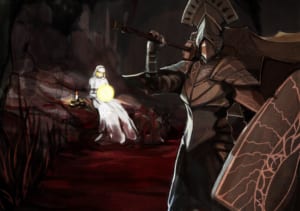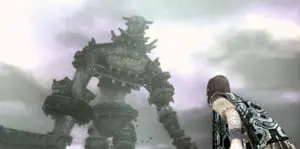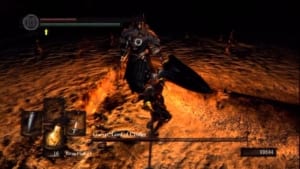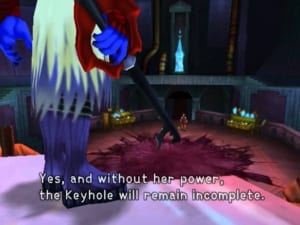The Souls series of video games, which started with Demon’s Souls in 2009 and ended with Dark Souls 3 in 2015, has seen considerable praise for many reasons. Top notch gameplay, a haunting atmosphere, brutal difficulty, and some of the most memorable bosses in gaming history garnered the loyalty of millions of gamers around the world. One aspect of the series, however, deserves more attention; the storytelling. The Souls method of storytelling does not stand out at first glance. It often feels nonexistent. Simplistic goals and the addictive challenge give you plenty of reason to soldier through the series’ relentless challenge.
For those who take the time to dig deep into the lore of these games, however, the storytelling ranks among the biggest strengths of these games. It’s minimalism at its finest.
Minimalist storytelling is a method involving little to nothing being told to the audience; rather, clues are placed within that hint at the plot and themes. With video games, this can apply to the environments the player travels through or the design of the enemies. It involves information given in ways besides dialogue, which players may not even notice. It’s also a storytelling method antithetic to the direction video game storytelling has trended towards for nearly 20 years now, where cutscenes resemble movies more and more with each generation.

The Souls series employs the method to a tee. Cutscenes are nearly nonexistent. Dialogue is sparse. Little to nothing is directly told to the player outside of your general objectives. You have to work hard to parse out the plot of these games.
Some love it. Some hate it. But no one can deny just how unique and utterly perfect this approach to storytelling is for the video game industry.
As I mentioned before, the world of Souls takes a lot of effort to gain an understanding of. Much of the lore is delivered by reading item descriptions. A set of armor or the soul of a boss provides a snippet of story which connects to other snippets from separate items. Talking with non-playable characters provides other bits of lore. Architectural clues and enemy placements provide visual evidence. Nothing is explicitly told to you besides the introductory cutscenes establishing the basic setup, and some characters near the beginning expanding a bit more of the story soon after the player takes control. From there you get your endgame goal, but little else explaining how or why things became the way they are.
Eventually players began noticing how those little tidbits of story linked together, and began putting it all together like a puzzle. They figured out how and why things became what they are. They figured out why a particular type of enemy only showed up in certain areas while others are encountered throughout the game. Histories behind the levels were revealed, as where the histories of bosses. A lot of it was (and still is) conjecture, without any canon confirmation by the developers, which has created a rich theory-crafting community among fans of the Souls series.
Reaching Maiden Astraea and Garl Vinland may feel underwhelming the first time through Demon’s Souls. Astraea is one of the five main bosses of the game yet she barely defends herself. In a game built so much around difficulty, the fight stands out as weak. When you parse out the details of her story and the evilness of killing her, it feeds into the increasing questions being asked of the player at this point. Just how far are you willing to go for power? Do you journey to save Boletaria or do you simply seek power?

Such is the central question of the Dark Souls series as well. From Software took the basic pieces laid down in Demon’s Souls and perfected them, creating a world as rich and memorable as any in gaming.
Rather than a hub world leading to separate, disconnected levels, Dark Souls provided gamers with one of the most impressively designed worlds in gaming history. This was a brilliant change that enhanced the strengths of this kind of minimalist storytelling. With every section of the world connected through various main paths and shortcuts, the world felt even more alive. The architectural hints were stronger. The enemy placement mattered even more. From Software added even more detail and lore to the items and collected souls. Covenants provided various factions connected to the bosses, whether through worship, alliance, or opposition.
A thousand small stories of failures and successes presented themselves to those interested in looking for them. You can beat the game without any idea what happened to the Witch of Izalith and her children. Sif may be nothing more to you than a badass giant wolf with a sword. You may not know Darkstalker Kaathe even exists. I didn’t for two full playthroughs. And while the game is certainly good enough on its gameplay alone to enjoy without knowing all this, it is the existence of all these stories and lore that elevates Dark Souls from a very good game to one of the best of all time.
By the time Dark Souls 3 rolled around in 2015, From Software took the formula to an even greater level. They combined the strength of the interconnected world of Dark Souls with the hub world concept of Demon’s Souls to create a world fans still theorize hotly about. What exactly is Lothric? Is the Firelink Shrine a real place, or some disconnected moment from time? Do each of the levels and bosses truly exist in the same moment or pull in from numerous timelines? A thousand clues big and small, from the concept of the game to small details in the geography of certain familiar landscapes, create room for many different interpretations. Returning characters from the original Dark Souls also place the timeline into doubt. And yet again, you can miss out on all of this entirely.
The great strength of this kind of storytelling exists purely because of gaming’s interactive nature. You could argue this kind of storytelling is the best compromise available of gaming’s ability to tell amazing stories through the player without getting in our way with excessive cutscenes or breaks in the action. The Souls series really represents the best of both worlds. Those who want a deeper story have it. Those who just want to play can ignore everything else.
This style allows gamers to truly feel the story, rather than have it told to them. Your level of connection is created organically. No cheap clichés demand you care. One of the worst storytelling sins a writer can commit is telling the audience how to feel rather than showing them. From Software uses their amazing environments and attention to detail to make you feel the story. I compared it earlier to a puzzle, and any puzzle is better when you put it together yourself rather than have someone giving you instructions. You experience the story rather than have it told to you.
If Demon’s Souls had a long cutscene explaining Astrea’s backstory, rather than using items and the level she inhabits to create a certain mood, gamers would more likely roll their eyes at the effortless manipulation than feel for her.
It is all highly reminiscent of Shadow of the Colossus, which is considered by many to be the pinnacle of minimalist storytelling. If you’ve never played it (and you should) the setup is simple; the main character must kill 13 Colossi throughout a barren world in order to wake a woman he loves from a coma. This is a simple setup with plenty of room for expansion that the game takes full advantage of. Not long after you begin, you realize there’s something off about your quest. The playable character’s appearance grows eviler with each “success.” Questions of what the Colossi are make you more and more hesitant. Like it’s equally subdued predecessor Ico, you feel the direction of the story, rather than observe it.

There are precious few games that have gotten this technique right since, which is part of why Ico and Shadow of the Colossus are such beloved and revered classics, yet From Software excels at this style. For example, there’s the final boss fight of Dark Souls against Lord Gwyn. You expect something terribly epic from the final boss of a game so challenging. You pass through that final fog wall expecting loud, boastful music and a boss of tremendous power. Instead haunting music and a withered husk of a man await you beside the fading embers of a fire.
(Not to suggest Gwyn was an easy fight. I suck at parrying, and if you can’t parry Gwyn will wreck you for a while.)
Here is where the pieces of the puzzle fell into place for me, a series of clues both direct and indirect as to what the hell happened to the world I spent so many hours struggling to conquer. The charred, ashen ruins of the Kiln of the First Flame. Gwyn’s Hollowed appearance so similar to the undead player. The importance of the Age of Flame to Gwyn and company’s victory over the dragons. Gwyn was no great king. He had long ago done the same thing the player is tasked with doing by linking the First Flame. In the process he had been killed, the Kiln and his knights burned, and all that was left was his undead Hollow desperately defending what was left of the flame.
It’s a stunning, haunting moment perfectly executed, and with very few words spoken to make it happen. The player sees the consequences of following in his footsteps and can then make the decision whether or not to link the First Flame yet again, sacrificing themselves to continue mankind’s Age of Fire.

However, the weakness in this kind of “hidden” storytelling is that you can miss every bit of it. Which raises the question if the moment really was perfectly executed. How could it be if the player doesn’t know or care why ash covers the Kiln and Gwyn is a Hollow?
This same criticism of a weak final boss existed for Demon’s Souls. After the epic challenge that is False King Allant, the true King Allant must be even tougher, right? Instead you fight some silly slug thing flailing around that left gamers disappointed. The storytelling purpose behind such an easy fight is wonderful; King Allant has been twisted by the power he sought through the Soul Arts. His pact with the Old One destroyed him. Here the player receives one final warning about the cost of power in a game filled with such warnings. You massacre this shell of a man and then decide whether to rid the world of this power or try to succeed where Allant failed.
Of course, none of this matters if the player missed it all.
Telling a story in the fashion of Demon’s Souls or Dark Souls will always be hit or miss for some gamers. Visual cues are very easy not to notice. Counting on players to actually read item descriptions and piece a story out of them will also fail with many. And can we really count on people to think on why a piece of music was arranged a certain way? From Software’s effort to keep their stories out of the way of the gameplay is appreciated, but sometimes it feels like a crying shame that so many don’t see their talent.
You will occasionally see this problem appear in the film industry as well. 2001: A Space Odyssey is now recognized as one of the great movies ever, but saw divisive reviews because of its reliance on visual cues and music to create an atmospheric story, which many did not pick up on for years. A big flaw of such limited storytelling is that many will not pick up on it the first, second, or even fifth time through. You can tell the greatest story ever penned and no one will notice until years or even decades later.
Minimalism might also be a relic of an older style of video game, one left behind as greater technology blurs the lines between movies and games. Games used to have to tell stories the way Demon’s Souls did because of graphical limitations. Dark Souls might as well be a Metroid game, and not just because of the similarities in level design and exploration. It’s as easy to overlook now as it was then, but Super Metroid told its story exactly like the Souls series does, through visual and musical cues and even less exposition than Souls.

Super Metroid may not look like much compared to today’s epic Final Fantasys or Naughty Dog games, but it’s one of the greatest video game stories ever told. The relationship between Samus and the young Metroid makes for one of the most heartbreaking and emotional final fights in gaming history. Traversing the environment tells the story of what happened to Planet Zebes since Mother Brain’s initial defeat. Every plot point is shown rather than told, and outside of the introduction not a single word is spoken.
Or maybe you’ll notice none of it.
Some gamers revere this kind of storytelling unconditionally. Back during the Super Metroid days, there was no better way to tell a story. No voice acting and simplistic graphics made developers rely on clue-placing within the levels and direct musical cues. Obviously Dark Souls does not have that problem. But does the fact games have almost universally moved on from this style damn it? Why risk the audience missing a point made through music that can be overtly made with a character’s expression or a line of well-voiced dialogue?
While the atmosphere of the Souls series gets praise from just about everyone, the story rarely gets mentioned by anyone. Even disregarding Dark Souls II (made by a different developer and mostly ignored by the third game), the Dark Souls series tells an atmospheric, sorrowful, complicated story of sacrifice and power. A story of kingdoms rising and falling and the role of destiny. The stories of dozens of minor characters tell you how and why they failed where the player must not.
Why does no one notice? Because it’s hard. The fact that so much of the Dark Souls canon is still up for debate tells you just how hard it is to parse the entire story. So many details are muddled and unclear. This makes for rich theorizing, certainly, but perhaps makes the story too complicated for single players to follow and understand without multiple playthroughs. Most gamers don’t put that effort into a single video game. As I mentioned before, this makes for possibly the best kind of video game, where the story is there if you want it but out of the way if you just want to enjoy the gameplay.
Telling a story plainly is easier than showing it, and much more likely to get a point across. Why hope the design of a building or landscape gets your point across when a single line of dialogue makes it clear? Why hope the player feels a certain way towards a character rather than tell you how you should feel? There’s a reason minimalism is always divisive and rarer than traditional forms. It’s hard to do right. Messing up a minimalist story just leaves both parties unsatisfied; the audience consuming it, and the creators trying for a certain theme or point.
A more dramatic focus also makes sure your big moments land. They get the hype for years. We still talk about the Sovereign confrontation from Mass Effect. Kratos’s rage sticks with you. So does Uncharted’s snappy dialogue. Who remembers story moments in Dark Souls? Very few of us. The prelude to Super Metroid’s final boss may be one of the most memorable moments ever, but it was also as dramatic as the Super Nintendo was capable of.
Minimalism also lacks the sexiness of a good brain-twister. Telling a highly complicated Metal Gear Solid-type plot betrays the very fundamentals of the concept. Where minimalism tries to keep plot movement small and focused, something like Kingdom Hearts tries for a grand scope and multiple agendas interplaying at all times, requiring considerable dialogue to make happen.
(Though Kingdom Hearts could definitely benefit from some minimalizing.)
I get why most developers go for the method more easily noticed and appreciated. For those of us who love a Souls-type story or a good Metroid game, seeing the style ignored sucks.
Games following the minimalist style also seem to struggle to sell like the bigger, epic games, and like the film 2001 go years without recognition of their quality. I could never get away with calling Ico and Shadow of the Colossus unknown games, but their popularity pales in comparison to the juggernauts of their time. Portal’s minimalism became more popular for the memes created than the actual story the clues told. Few rank Prince of Persia: The Sands of Time the way they do God of War. Telling a minimalist story requires an understanding that your game will likely go unappreciated at first and may fail entirely. Gamers always want more more more and minimalism is all about less.
The increasing costs within the gaming industry have created a ruthless atmosphere. The risk is harder and harder to take. You simply can’t afford to spend years creating a game that fails because no one understands your approach to the story and would rather play the next Dragon Age.

All that said, minimalism maintains an important place in gaming for a reason; when it hits, it hits hard. It is a style perfect for the medium and always will be, no matter where technology takes us. This especially shows in the indie scene. Games like Journey or Brothers: Tale of Two Sons have provided some of my favorite modern moments without speaking a word. With less budget and tech capability, indie studios instead focus on communicating as much as they can visually with their limited resources, creating some of the most atmospheric games in recent memory.
Big budget games, however, can also take advantage of their ever-increasing technological power. After all, better graphics and sound mean increased capability for storytelling through environments and soundtracks. Small details are possible where they never have been. Even hugely dramatic games rely on minimalist techniques to deliver climactic moments. Nintendo has spent years relying on visual, simplistic storytelling. The Last of Us does not explicitly tell you Joel is the bad guy for “rescuing” Ellie. Instead his history and the moment speaks for itself to instill that feeling in the player as it happens.
Video games are unique in the amount of interaction with their audience. Developers will always be best off taking advantage of that interaction. No cutscene could possibly display Sephiroth’s power any clearer than that brief segment of Final Fantasy VII where you play as him. Nothing creates a connection to Alyx in Half-Life 2 the way fighting alongside her does. Taking control from the player to show cutscenes and dialogue in excess will always draw criticism. As a Metal Gear Solid fan, I’ve seen such backlash twice now.
True minimalist games will likely continue to decrease as the industry’s ability to tell cinematic stories increase. Minimalism, however, will never go away entirely. With the increasing cost of games, every cent spent matters more and more to the profit on the other end. It also takes such advantage of the interaction video games provide. Developers will always find ways to communicate through gameplay and graphics rather than long cutscenes divorcing player control from the story. The ability to create emotional impact through the gameplay is the holy grail of game design.
And there’s a reason for that. When done right, minimalism will stick with you longer than anything else.
Images Courtesy of From Software, Square Enix, Nintendo, and Sony Computer Entertainment

